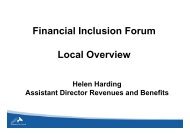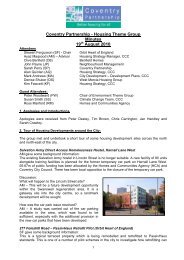Sustainable Community Strategy - Coventry Partnership
Sustainable Community Strategy - Coventry Partnership
Sustainable Community Strategy - Coventry Partnership
Create successful ePaper yourself
Turn your PDF publications into a flip-book with our unique Google optimized e-Paper software.
How will the strategy be achieved?<br />
1.9 <strong>Coventry</strong> - The Next Twenty Years will be used<br />
to inform the development of a range of key<br />
strategies and organisationsʼ plans, that will help to<br />
deliver the improvements and activities needed to<br />
achieve the agreed strategic long term outcomes for<br />
the city (see diagram 1). Examples include the city's<br />
Children and Young People's Plan, the Climate<br />
Change strategy and the Economic Development<br />
<strong>Strategy</strong>.<br />
1.10 The <strong>Coventry</strong> Local Development Framework<br />
(LDF) sets out the policies that provide for the<br />
spatial planning and future physical development of<br />
<strong>Coventry</strong> and is particularly important to the<br />
achievement of the <strong>Sustainable</strong> <strong>Community</strong><br />
<strong>Strategy</strong> so central government has advised that the<br />
Core <strong>Strategy</strong> of the LDF should become part of the<br />
city's <strong>Sustainable</strong> <strong>Community</strong> <strong>Strategy</strong>.<br />
1.11 Also important to delivering the long-term<br />
outcomes of the <strong>Sustainable</strong> <strong>Community</strong> <strong>Strategy</strong><br />
will be the city's new Local Area Agreement (LAA).<br />
The Local Area Agreement will be signed between<br />
the <strong>Coventry</strong> <strong>Partnership</strong>, <strong>Coventry</strong> City Council and<br />
central government and will set out up to 35 agreed<br />
priorities with improvement targets across a range of<br />
areas such as employment and skills, housing,<br />
environment, community safety and health. There<br />
will also be an additional 16 statutory targets for<br />
early years and educational attainment in schools.<br />
LAA priorities and targets are based upon the<br />
national indicator set for local authorities and local<br />
authority partnerships that has been developed by<br />
central government.<br />
1.12 The new Local Area Agreement has a threeyear<br />
time scale and will include short-term priorities<br />
that will help to achieve the long-term objectives and<br />
outcomes of the <strong>Sustainable</strong> <strong>Community</strong> <strong>Strategy</strong>.<br />
These priorities are evidence based and build upon<br />
the analysis of the current position in <strong>Coventry</strong>,<br />
expected future trends and the priorities and<br />
strategies that have been agreed with central<br />
government, local partner organisations and local<br />
people and communities.<br />
1.13 To measure progress and to ensure that we<br />
achieve our objectives, action plans will be<br />
developed for each of the priorities of the Local Area<br />
Agreement and a robust performance management<br />
framework will be developed.<br />
2. About our city<br />
2.1 <strong>Coventry</strong>, with 306,600 residents (Office of<br />
National Satistics 2006 estimate), is the eleventh<br />
largest city in the UK. It is the centre of a sub-region<br />
serving half a million people. The city grew<br />
throughout the early and mid twentieth century with<br />
migrants settling in the city from across the UK,<br />
Ireland and the Indian sub-continent.<br />
2.2 Following rapid population decline associated<br />
with economic restructuring during the 1980s, the<br />
city's population stabilised in the 1990s and is now<br />
beginning to grow.<br />
2.3 <strong>Coventry</strong> covers an area of approximately 9,864<br />
hectares and is of a predominantly urban character.<br />
The cityʼs urban form is tightly constrained, being<br />
almost entirely bordered by the West Midlands and<br />
Warwickshire Green Belts. To accommodate its<br />
growth, <strong>Coventry</strong>ʼs boundaries have been changed<br />
and extended several times during the last century,<br />
with the latest additions happening in 1994.<br />
2.4 Industrial areas of <strong>Coventry</strong> and the pre-First<br />
World War city extend to the north of the City<br />
Centre, with the twentieth century suburbs radiating<br />
outwards. The city expanded considerably in the<br />
inter-war period (1918-1939), with a large number of<br />
homes being built across the city. Late twentiethcentury<br />
development has taken place to the south<br />
and east of the city or by redevelopment of the<br />
urban areas.<br />
2.5 <strong>Coventry</strong>ʼs rail communications with London, the<br />
countryʼs motorway network, the revived local<br />
economy and the cityʼs two universities give some<br />
key ingredients for future economic growth and<br />
prosperity.<br />
<strong>Coventry</strong> people<br />
2.6 <strong>Coventry</strong> has a younger population than the<br />
average for England with 24% under 18 years of<br />
age and 35% under 24. The high proportion of 18-<br />
24 year olds reflects the fact that the city has two<br />
successful universities - <strong>Coventry</strong> University and the<br />
University of Warwick - and the city has a higher<br />
percentage of children than average. The "State of<br />
the Cities" report identified <strong>Coventry</strong> as one of only<br />
six cities in the UK where the population was getting<br />
younger on average. The percentage of <strong>Coventry</strong>'s<br />
population that is over 65 is 16%, lower than the<br />
national average.<br />
2.7 Life expectancy in <strong>Coventry</strong> is increasing slowly<br />
and the city currently has 6,200 people aged over<br />
85 a group that is expected to grow to 6,900 by<br />
2011 and to 8,000 by 2021 (Office of National<br />
Statistics 2004 projection).<br />
2.8 The city is ethnically diverse, with 22% of<br />
<strong>Coventry</strong>'s inhabitants coming from minority ethnic<br />
communities compared to 13% for England as a<br />
whole. About a quarter of the children in <strong>Coventry</strong>'s<br />
schools are from minority ethnic backgrounds. Asian<br />
and Asian British communities together make up<br />
11.3% of the city's population of whom 8.0% have<br />
an Indian background. The next largest minority<br />
group is people with a White Irish background who<br />
make up 3.5% of the population. <strong>Coventry</strong>'s<br />
population with a Black or Black British background<br />
is 1.8% - slightly lower than the English average of<br />
2.3%.<br />
2.9 Newer communities settling in <strong>Coventry</strong> in the<br />
last ten years include Somalian, Kurdish, Afghani<br />
and Iraqi groups. The city is also currently benefiting<br />
from economic migrants from the new accession<br />
states in the European Union, including Poland.<br />
There are over 100 languages spoken in <strong>Coventry</strong>.<br />
7
















